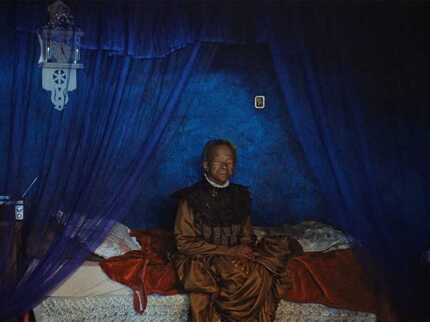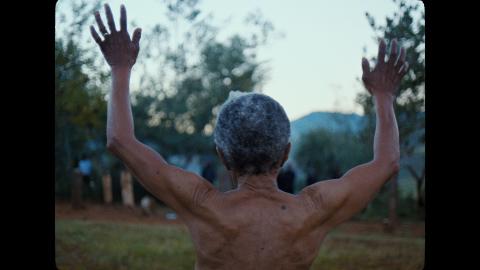Blu-ray Review: THIS IS NOT A BURIAL, IT'S A RESURRECTION, The Poetics of Resistance

With only one or two 'big' names known, even among cinephines, cinema from sub-saharan Africa has often been neglected both on the festival and the art house cinema circuit. Perhaps also because of the way the filmmakers use the tools of cinema, often so outside what we're used to from North American, European, and Asian cinema. It's a different way of storytelling, one that asks us to consider the web-like connection between storyteller and story, land and character, fiction and fact. These are not seperated categories, but each a part of each other.
Lemohang Jeremiah Mosese's sophomore feature, This is Not a Burial, it's a Resurrection is a film that asks for, and has no trouble receiving, our undivided attention. The story might seem simple enough on proverbial paper, but its complexities are as deep as the attachment to the land of its characters. The elderly Mantoa (Mary Twala) is the last of her family: her husband, her grandchildren are gone, and now the her last child, killed presumably in an accident. She decides she's ready to die, even trying to find someone to dig her grave and laying on her bed in her coffin garb, but it seems the universe has other plans. Namely, to lead a movement to stop a dam that will flood her village, and with it the cemetery that is home to her family.
As my colleague Dustin Chang wrote in his review, this is "a stunning film that defies easy categorization. Gorgeously shot in full frame by Pierre de Villiers with captivating score by Berlin based electronic composer Miyashita Yu, the film is a highly visual, aural experience that charts new frontier in its cinematic language. Only comparison I can think of is the work of Pedro Costa in its painterly, static framing and its visual poetry."
This is a film of landscapes: the landscape of hills and valleys, of flocks of sheep and graveyards and colonization and independence and the ongoing struggle to keep that landscape. But's also a landscape of faces, especially the face of Mantoa. She is a history of herself, her family and her village. She should be able to pass in peace, but instead burns with this final fire that will light the flames of resistance.
This is also a film of poetry. The poetry of that landscape, and the poetry of storytelling. What are the moments we must remember of a community, to be a community? The sheep-shearing scene, the umbilical cord burial, Mantoa stripping naked as an act of resistance, the community clearing long-strewn rubbish. The heart might be Mantoa, but then guiding that heart is that storyteller: perhaps her is from the village and recounting the tale to those where he lives now, perhaps he is in some future time and remembering the past. Either way, his voice is another landscape, the bard of this poem.
Mosese's tale is one of love and anger, of a people forgotten and yet reborn again, weaved in a tapestry as complex and rich as the hills of Lesotho itself. It's one that holds up even more on rewatching, it's story with such depth that you could find new parts to explore with each viewing.
Special Features
This is a visually and aurally rich film; seeing it in a cinema is preferred, but having it in physical form from Criterion is the next best thing. The 2K digital master brings all the vibrancy of colour to your home screen, along with the surround sound. I still recommend keeping the room as dark and quiet as possible to have the story's richness envelop you, as Mosese (who approved the master) intended.
For me, a film commentary should be part of the third or fourth viewing of a film. It was a joy to listen to Mosese and producer Cait Pansegrouw discuss the inpirations for the films, how they took over a Lesotho village and how the villagers embraced the film. And how, it turns out, star Twala is was bad-ass 81-year-old diabetic chain smoker who had no problem with getting naked in one of the climatic scenes. It lends so much to the idea of this film not just as folklore but as resistance and revolution, the struggle to make the film, and the joys that came with the hardships.
Zakes Mda's thoughtful essay provides some good historical, contemporary political, and environmental context to the story (about British colonization, current economic fortunes), as well as more detailed information about the various groups that inhabit the region. Lesotho is made up of several tribes, and the importance of magical realism and storytelling is one that cannot be represented in western fashion. As they write, this is a Lesotho story told in a Lesothan way, as much a 'narrative art installation' as a film.
The dics also has two shorts and Mosese's first feature, along with an introduction from him. Mosese discusses how his first inspirations were the hands of faces of the women of this land, how this showed him the Africa from within. His film inspirations are as diverse as Platoon and The Warriors, and he has often found his identity torn between his homeland and his current home of Berlin; as a black man, he has never been quite welcomed in the latter, but his homeland is not longer his anymore, and as someone who has left, he is sometimes seen as an outsider.
His second and third shorts, Mosonngoa and Behemoth or The Game of God respectively, seem different on the surface. The first, of which the title translates as 'the mocked one', tells the story of Lesotho's only known female stick fighter. It's a slow-burn tale of a young woman's struggle to survive in a culture still feeling the effects of colonialism and the sexism and poverty it brought to the land. The second is a strange tale of a preacher man, dragging a coffin into the city, claiming that the people must find the true word of god, while this god apparently waits in the coffin. A mix of discordant music, slo motion, and handheld camera intimacy and provocation makes for a violent end to this story.
Mosese's feature, Mother, I am Suffocating. This is My Last Film About You, an essay on the filmmaker's fraught relationship with Lesotho, is a combination of love letter, lament, and angry shout to the heavens. A young woman walks through the street, dragging on her back a crucifix. In black and white, she sees the images of her people: moss on the river rocks, flocks of sheep, fruits and flowers, trash, political rallies. Her voice is heard as phone messages left on an answering machien that might or might not be heard. It is an internal view of this tiny country, for an external understanding that could only come from someone who has experienced a place from the inside and the outside.
This Is Not a Burial, It's a Resurrection
Director(s)
- Lemohang Jeremiah Mosese
Writer(s)
- Lemohang Jeremiah Mosese
Cast
- Mary Twala
- Jerry Mofokeng
- Makhaola Ndebele








